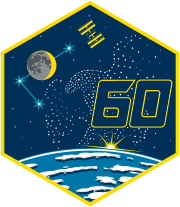ISS-Expedition 60
| Missionsemblem | |||
|---|---|---|---|
 | |||
| Missionsdaten | |||
| Mission | ISS-Expedition 60 | ||
| Besatzung | 6 | ||
| Rettungsschiffe | Sojus MS-12, Sojus MS-13 | ||
| Raumstation | Internationale Raumstation | ||
| Beginn | 24. Juni 2019, 23:25 UTC | ||
| Begonnen durch | Abkopplung von Sojus MS-11 | ||
| Ende | 3. Oktober 2019, 07:37 UTC | ||
| Beendet durch | Abkopplung von Sojus MS-12 | ||
| Dauer | 120d 8h 12min | ||
| Mannschaftsfoto | |||
 v. l. i. UZS.: Christina Hammock Koch, Alexei Owtschinin (Kommandant), Nick Hague, Luca Parmitano, Alexander Skworzow und Andrew Morgan | |||
| Navigation | |||
| |||
ISS-Expedition 60 ist die Missionsbezeichnung für die 60. Langzeitbesatzung der Internationalen Raumstation (ISS). Die Mission begann mit dem Abkoppeln des Raumschiffs Sojus MS-11 von der ISS am 24. Juni 2019 und endete mit dem Abkoppeln von Sojus MS-12 am 3. Oktober 2019.
Im Emblem der Mission ist ein Adler angedeutet. Es nimmt damit Bezug auf das Logo der Apollo-11-Mission, deren 50-jähriges Jubiläum in den Zeitraum der Expedition fiel. Die Mondlandefähre von Apollo 11 trug den Namen Eagle (Adler).
Mannschaft
Von ISS-Expedition 59 übernommen:
- Alexei Nikolajewitsch Owtschinin (2. Raumflug), Kommandant (Russland/Roskosmos, Sojus MS-12)
- Tyler N. Hague (1. Raumflug), Bordingenieur (USA/NASA, Sojus MS-12)
- Christina Hammock Koch (1. Raumflug), Bordingenieurin (USA/NASA, Sojus MS-12)
Zusätzlich ab 20. Juli 2019:
- Luca Parmitano (2. Raumflug), Bordingenieur, (Italien/ESA, Sojus MS-13)
- Alexander Alexandrowitsch Skworzow (3. Raumflug), Bordingenieur (Russland/Roskosmos, Sojus MS-13)[1]
- Andrew Morgan (1. Raumflug), Bordingenieur, (USA/NASA, Sojus MS-13)
Nachdem die ISS bis Expedition 59 nach dem Abdocken einer Sojus für kurze Zeit mit nur drei Personen besetzt war, wurde die Reihenfolge beginnend mit Expedition 60 umgekehrt. Darum stießen am 25. September 2019 mit Sojus MS-15 folgende Gäste zu den Teilnehmern der Expedition 60:
- Oleg Skripotschka (3. Raumflug, Russland/Roskosmos, Sojus MS-15)
- Jessica Meir (1. Raumflug, USA/NASA, Sojus MS-15)
- Hassa al-Mansuri (1. Raumflug, UAE/MBRSC, Sojus MS-15/MS-12)[2]
Ersatzmannschaft
Seit Expedition 20 wird wegen des permanenten Trainings für die Besatzungen keine offizielle Ersatzmannschaft mehr bekanntgegeben. Inoffiziell gelten die Backup-Crews der beiden Sojus-Zubringerraumschiffe MS-12 und MS-13 (siehe dort) als Ersatzmannschaft der Expedition 60. In der Regel kommen diese Crews dann jeweils zwei Missionen später selbst zum Einsatz.
Missionsbeschreibung
In den ersten vier Wochen der Expedition war die ISS nur mit dem Kommandanten Alexei Owtschinin und den Bordingenieuren Nick Hague und Christina Koch besetzt. Am 20. Juli 2019 erreichte das Zubringerschiff Sojus MS-13 nach etwa sechsstündigen Flug die Station, sodass die Expeditionscrew wieder auf sechs Personen verstärkt wurde.
Am 2. Oktober übernahm Luca Parmitano als erster Italiener das Kommando über die ISS.[3] Nach dem Abdocken von Sojus MS-12 mit Owtschinin, Hague und al-Mansuri begann am 3. Oktober die ISS-Expedition 61.
Siehe auch
- Liste der bemannten Raumflüge
- Liste der Weltraumausstiege
- Liste der ISS-Expeditionen
- Liste der Raumfahrer auf der Internationalen Raumstation
Weblinks
- ISS-Expedition 60 auf den Seiten der NASA (englisch)
- ISS-Expedition 60 bei Spacefacts.de
Einzelnachweise
- ↑ Экипажи на подготовке. Центр подготовки космонавтов имени Ю. А. Гагарина, abgerufen am 10. Dezember 2017 (russisch).
- ↑ MBRSC selects Hazzaa Al Mansoori as Prime Astronaut for ISS Mission. Emirates News Agency, 12. April 2019, abgerufen am 12. April 2019.
- ↑ Expedition60 to Expedition 61 Change of Command Ceremony - October 2, 2019. NASA-Video auf Youtube, 2. Oktober 2019.
Auf dieser Seite verwendete Medien
The official Expedition 60 crew portrait with (clockwise from top right) astronauts Nick Hague of NASA and Luca Parmitano of ESA (European Space Agency), Roscosmos cosmonaut Alexander Skvortsov, NASA astronauts Drew Morgan and Christina Koch and Roscosmos cosmonaut Alexey Ovchinin.
The Expedition 60 crew insignia
- The Moon landing is one of the most extraordinary feats of humankind, an embodiment of ingenuity and desire for exploration. The patch of Expedition 60 commemorates the 50th anniversary of that landing: a constellation of three stars with the Moon superimposed forms the letter “L,” the Latin symbol for 50. The Moon is depicted as a waxing crescent, as it was on July 20, 1969.
- The familiar silhouette of the International Space Station is visible, flying across the night sky. Stars, numerous and bright as seen from the space station, form the shape of an eagle in the same pose as on the iconic patch of the Apollo 11 mission. The sunrise represents the fact that we are still in the early stages of humanity’s exploration of space.
- The hexagonal shape of the patch represents the space station's cupola, with the six points of the hexagon symbolizing the six crewmembers of Expedition 60. The names and nationalities are not present, as on the original Apollo 11 mission patch, to highlight that space missions – then, now, and in the future – are for Earth and all humankind.
The expanded six-member Expedition 60 crew gathers in the Zvezda service module for a crew greeting ceremony with family, friends and mission officials on the ground. In the front row from left, are Flight Engineers Luca Parmitano, Alexander Skvortsov and Andrew Morgan. In the back are Flight Engineer Nick Hague, Commander Alexey Ovchinin and Flight Engineer Christina Koch.





